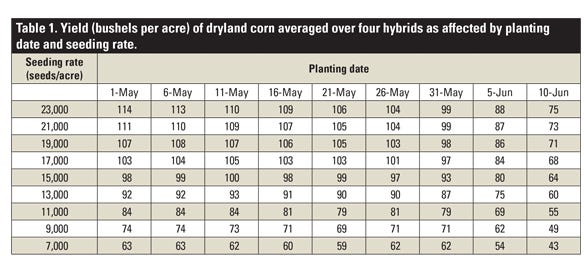
Back in 2017, when parts of western Nebraska dealt with early-season drought, a number of farmers noticed their late-planted dryland corn yielded better than earlier-planted dryland corn.
"The earliest-planted dryland corn just died. There was a stretch of nine weeks without rain in May and June that really made a difference," says Strahinja Stepanovic, Nebraska Extension educator in southwest Nebraska. "Growers were asking questions, because the official [Risk Management Agency] policy for getting full insurance on corn is you've got to plant before May 25. In western Nebraska, having a shorter season, and having late-planted corn yield better is just mind-blowing."
So, in 2018, Stepanovic tested different populations and planting dates among four different corn hybrids on a 75-acre dryland field at the Henry J. Stumpf International Wheat Center at Grant. This included dryland corn planted at intervals of 2,000 seeds per acre from 7,000 to 23,000, and on five-day intervals from May 1 to June 10.
"On the population side, think about how the corn plant has changed over the years, and we haven't revisited seeding rates on dryland corn for 30 to 40 years," Stepanovic says.
However, 2018 turned out to be an unusual year for western Nebraska, with about 6 inches above-average rainfall in spring. So, even though 2018 wasn't the perfect year to research whether late planting improved corn yields during drought, Stepanovic notes it provided some insights into hybrid selection under different populations and planting dates in dryland situations.
But first, how did seeding rate and planting date affect final yield?
The yield penalty for planting dryland corn ranged from 0.5 to 1.0 bushel per acre per day after May 1, depending on the seeding rate. However, that increment got larger the later corn was planted. At some populations, moving planting back from May 31 to June 10 resulted in a 24-bushel loss.
Corn yields responded well to higher seeding rates over 19,000 across all planting dates, but especially at early planting dates from early to mid-May. However, increasing seeding rate beyond 15,000 seeds per acre was rarely economically justified at later planting dates.
"When you plant later, you usually think you should increase the seeding rate, and that bumps up the yield," Stepanovic says. "If you plant early and plant over 15,000 [seeds per acre], there's potential to increase yield and profit — but not if you plant late. We are pretty much settled on 14,000 to 15,000. If you plant early, I think it could pay off in certain years to bump it up to 23,000. It depends on planting date and hybrid recommendations."
"If the corn price is $7, it might make a difference," he adds. "At some point, every crop starts to plateau on that yield response to population. That's where market price and seed cost really start to factor into your total cost."
For example, corn planted on June 10 saw a yield increase from 49 to 55 bushels per acre when increasing seeding rate from 9,000 to 11,000, but only 2 bushels, from 73 to 75 bushels per acre when increasing the seeding rate from 21,000 to 23,000. Each increase in seeding rate saw a yield increase this year, but the optimal seeding rate depends on the economic climate.
Of course, the hybrid makes a big difference. Hybrid performance varied by planting date and seeding rate. While the Golden Harvest hybrid performed best (both for yield and profit) at early planting and higher seeding rates, the other hybrids performed well during different periods:
• Croplan hybrid with a mid-May planting at seeding rates above 15,000 seeds per acre
• Dekalb hybrid at later planting dates
• Pioneer hybrid with seeding rates below 15,000 seeds per acre, regardless of planting date
"The best thing about the hybrids we planted is they all dominated in different areas," Stepanovic says. "We usually just pick out hybrids and plant them wherever and whatever seeding rate we want. If you're planting higher seeding rates and planting early, you maybe should consider a different hybrid than if you're planting later. It's about understanding genetics and how they respond to the ."
Stepanovic plans to continue this study in the 2019 growing season.
"This gives us some insight into how important it is to have a strategy to use different hybrids at different planting dates for different reasons," Stepanovic adds. "When it comes to determining optimal seeding rates for different planting dates, we really need more than one year of research data to show what the trends are."
About the Author(s)
You May Also Like




